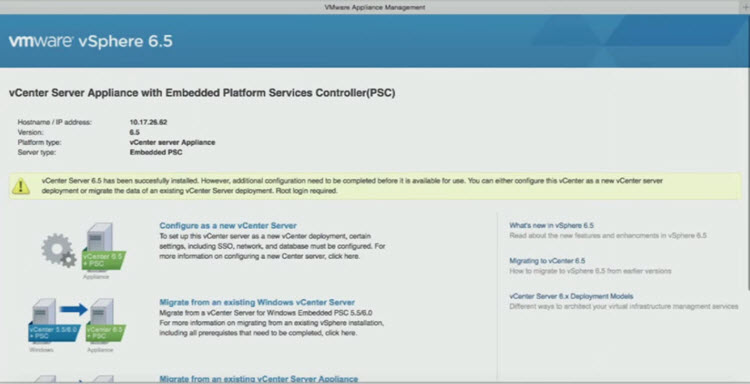

Vsphere client 6.5 vicfg cfgbackup password#
After placing the host into maintenance mode, the restoration command under PowerCLI might look something like this: Set-VMHostFirmware -VMHost host_IP_address -Restore -SourcePath backup_file -HostUser username -HostPassword password Note that the command-line syntax under PowerCLI again differs substantially from the syntax under vSphere CLI. In this example, the root_pw is the root password for the ESXi host. If admins don't want the additional prompt, it's possible to add a password switch to the command line: -server=host_IP_address -username=root -password=root_pw -s file_name If there is a root password protecting the host, the recovery process asks for the password before proceeding. Here, the host_IP_address is the IP address of the ESXi host, and the file_name is the name of the backup file to restore. server=host_IP_address -username=root -1 file_name When restoring an ESXi host configuration, admins should first power off all VMs on the host, access the CLI, such as vSphere CLI for Windows, and run the backup command line with the -1 flag. Restoration compares the universally unique identifier of the host with the UUID of the backup and won't restore backups to hosts with different UUIDs, though admins can override this protection. Once admins create the ESXi host backup, they can restore the ESXi host configuration and vSphere switch configuration. Platforms such as VMware ESXi enable admins to back up and restore ESXi host configuration using a CLI, such as vSphere CLI or PowerCLI. The same backup command in PowerCLI might appear as: Get-VMHostFirmware -VMHost host_IP_address -BackupConfiguration -DestinationPath output_dirĪs with the vSphere CLI example, the host_IP_address is the IP address assigned to the ESXi host, and the output_dir is the target directory of the backup file.

The command-line syntax under PowerCLI differs substantially from the syntax under vSphere CLI.

If admins don't want the additional prompt, they can add a password switch to the command line, such as: -server=host_IP_address -username=root -password=root_pw -s file_name If a root password protects the host, the backup process prompts the admin for the password before proceeding. In many cases, the target file name appears as a compressed format, such as TAR, so it's important to include the file name extension, such as test_backup.tgz. In this command-line example, the host_IP_address is the IP address assigned to the ESXi host, and the file_name is the desired name of the backup file being created.
Vsphere client 6.5 vicfg cfgbackup windows#
Platforms such as VMware ESXi enable admins to back up and restore ESXi host configuration using a command-line interface (CLI), such as vSphere CLI or PowerCLI.Īn ESXi host configuration backup under Windows might use a vSphere CLI command line, such as: -server=host_IP_address -username=root -s file_name Since the stability and performance of a host impacts all the VMs operating on the physical system, protecting the host is crucial. Nowadays, host usually means the bare-metal hypervisor installed and configured on a physical system, such as VMware ESXi. The hypervisor host is the VM that contains the hypervisor and manages the underlying physical system - distributing and managing VMs containing one or more guest workloads. Such flexibility is powerful, but organizations must make the best choices and adopt solid practices to ensure that they properly protect each workload.Įxperts traditionally distinguish virtualization with host and guest terminology. IT administrators can often apply a variety of alternatives and options differently to each workload. The explosive growth of virtualization platforms, such as VMware vSphere, has introduced additional challenges to workload protection.


 0 kommentar(er)
0 kommentar(er)
